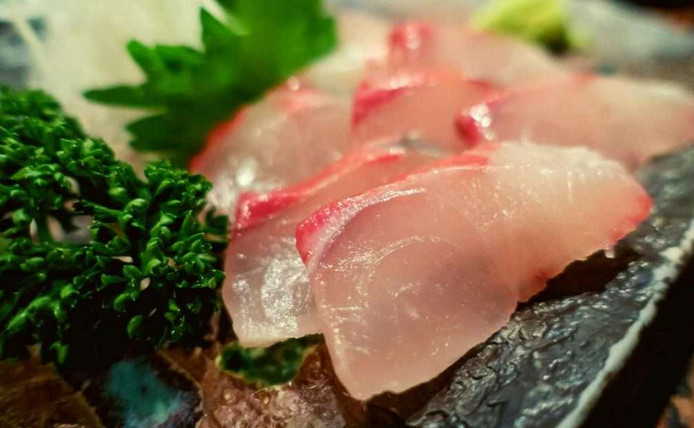What Does Yellowtail Taste Like?

What Does Yellowtail Taste Like?
Yellowtail is a popular fish that is often served in sushi restaurants and is a favorite among seafood lovers. Many people who have never tried yellowtail before may be curious about what it tastes like. In this article, we’ll explore the flavor, texture, and common preparation methods for yellowtail, as well as answer “What Does Yellowtail Taste Like?”
So, What Does Yellowtail Taste Like?
Yellowtail has a mild, sweet taste that is often described as similar to a combination of tuna and salmon, but with a firmer and meatier texture. It’s not as fatty as salmon or as chewy as tuna, but it does have a buttery, smooth texture that melts in your mouth.
Some people compare the flavor of yellowtail to that of other white fish such as halibut or sea bass, but with a mildly sweet taste. Overall, yellowtail is a versatile fish with a subtle flavor that pairs well with a variety of seasonings and preparations.
Flavor
Yellowtail has a mild, sweet taste that is often described as similar to that of mahi-mahi or swordfish. The flavor is not overpowering and is generally well-received by those who enjoy seafood. Some people may detect a slight “fishy” taste, but this is not uncommon for most types of fish.
Texture
The texture of yellowtail is firm and meaty, but not tough. It is a flaky fish with a delicate texture that easily absorbs flavors from marinades or sauces. Many people enjoy the texture of yellowtail because it is not too chewy or stringy like some other types of fish.
How To Cut And Clean Yellowtail?
Cleaning and cutting yellowtail, or any fish, involves removing the head, tail, scales, and internal organs to leave behind the fillets. Here’s a general guide on how to clean and cut yellowtail:
Ingredients and tools:
- Whole yellowtail fish
- Cutting board
- Sharp fillet knife
- Tweezers or pliers
- Paper towels
Instructions:
- Preparation:
- Ensure your cutting board and knife are clean and sharp.
- Have paper towels nearby for cleanup.
- Rinse the yellowtail under cold running water to remove any loose scales or debris.
- Scaling:
- Use the back of the knife or a fish scaler to remove scales. Scale from tail to head in smooth, even strokes.
- Head Removal:
- Place the yellowtail on the cutting board with the belly facing up.
- Make a diagonal cut behind the pectoral fin towards the head.
- Turn the knife and make a straight cut towards the backbone, just behind the head.
- Repeat on the other side to remove the head.
- Gutting:
- Make a shallow incision along the belly from the anus towards the head.
- Use your fingers or a spoon to gently scoop out the internal organs.
- Rinse the cavity thoroughly under cold water.
- Tail Removal:
- Cut off the tail by making a horizontal cut just above the tail fin.
- Fillet the Yellowtail:
- Position the yellowtail on its side with the dorsal fin facing you.
- Make a vertical cut behind the pectoral fin towards the backbone.
- Follow the backbone, using gentle, sweeping motions to separate the fillet from the bones.
- Repeat the process on the other side.
- Rib Cage Removal:
- Lay each fillet skin-side down.
- Run the knife along the rib cage to separate the fillet from the bones.
- Skinning (Optional):
- To remove the skin, start at the tail end and slide the knife between the flesh and skin, using a gentle back-and-forth motion.
- Check for Bones:
- Run your fingers over the fillets to check for any remaining bones. Use tweezers or pliers to remove any pin bones.
- Rinse and Pat Dry:
- Rinse the fillets under cold water to remove any remaining scales or debris.
- Pat the fillets dry with paper towels.
Now you have cleaned and filleted your yellowtail, ready for cooking. Remember that practice improves filleting skills, so don’t be discouraged if it takes a few attempts to become more efficient.
How Do You Cook Yellowtail ?
Yellowtail can be prepared in a variety of ways, including grilling, baking, broiling, and pan-frying. Some popular dishes that feature yellowtail include sushi rolls, ceviche, and grilled fillets. Many chefs recommend seasoning yellowtail with citrus, herbs, or spices to enhance the flavor and complement the natural sweetness of the fish.
Here are some preparation tips to keep in mind when cooking yellowtail:
- To grill yellowtail, brush the fish with olive oil and season with salt and pepper. Cook on a hot grill for 5-7 minutes on each side, or until the fish flakes easily with a fork.
- To bake yellowtail, preheat the oven to 375°F. Place the fish in a baking dish, season with your desired ingredients, and cover with foil. Bake for 15-20 minutes, or until the fish is cooked through.
- To make ceviche, cut the yellowtail into small cubes and marinate in lime juice and salt for at least an hour. Mix with diced onion, tomato, cilantro, and avocado for a refreshing and flavorful dish.
Yellowtail in Sushi
Yellowtail is a popular ingredient in sushi rolls and sashimi. It is often served raw and has a buttery, melt-in-your-mouth texture. Yellowtail sashimi is a popular choice for sushi lovers who enjoy the delicate flavor and texture of this fish.
Yellowtail sushi is commonly served in sushi restaurants around the world, either as a standalone nigiri or as part of a sushi roll. Many sushi chefs recommend pairing yellowtail with ingredients like scallions, ginger, or sesame seeds to bring out the natural flavors of the fish.
Other Related Questions:
- What Does Salmon Sushi Taste Like? Salmon sushi has a rich flavor that can range from mild to bold, depending on the type of salmon used. It has a buttery texture and is often served raw in sushi restaurants.
- What Kind of Fish is Yellowtail? Yellowtail is a type of fish that is found in both the Pacific and Atlantic Oceans. In Japan, it is known as “hamachi” and is a popular ingredient in sushi and sashimi dishes.
- Tuna Flavor: Tuna has a distinct, meaty flavor that is often described as strong and slightly “fishy” compared to other types of fish. It is a common ingredient in sushi rolls and is usually served raw or lightly seared.
- Yellowtail Recipe: Here is a simple yellowtail recipe that you can enjoy:
Pan-Seared Yellowtail with Lemon and Thyme
Ingredients:
- 2 yellowtail fillets
- 1 lemon, sliced
- 4 sprigs of fresh thyme
- Salt and pepper to taste
- 2 tbsp olive oil
Instructions:
- Season the yellowtail fillets with salt and pepper on both sides.
- Heat up 2 tbsp of olive oil in a non-stick pan.
- Place the seasoned fillets on the pan, skin side down. Cook for about 3 minutes until the skin is crispy.
- Flip the fillets and add the sliced lemon and fresh thyme. Cook for another 3 minutes until the fish is cooked through.
- Serve the yellowtail hot with the lemon and thyme on top.
Yellowtail Sashimi
Yellowtail sashimi is a popular Japanese dish that features thinly sliced raw yellowtail served with soy sauce, wasabi, and other seasonings. It has a soft, buttery texture and a sweet, delicate flavor that combines well with the salty and spicy flavor of the soy sauce and wasabi.
Yellowtail sashimi is often served with the skin on, which adds a slightly crunchy texture to the dish. Many sushi chefs recommend serving yellowtail sashimi in thick slices to showcase its beautiful pink color and delicate texture.
Read more: What Does Flounder Taste Like?
Conclusion
In conclusion, yellowtail is a versatile and delicious fish that offers a mild, sweet taste and a firm, delicate texture. Whether you prefer it grilled, baked, or raw in sushi rolls or sashimi, yellowtail is sure to satisfy your taste buds.
With its sweet and delicate flavor, yellowtail pairs well with citrus, herbs and spices. If you are looking to try something different from the usual salmon and tuna, give yellowtail a try!






